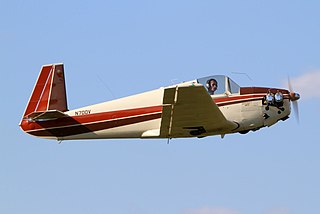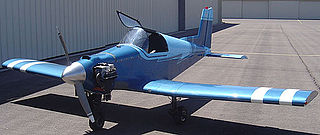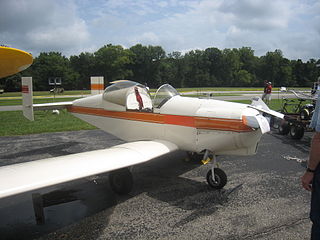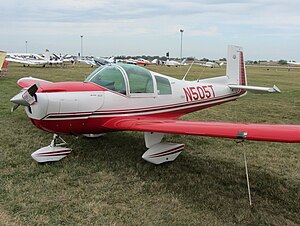
In flight dynamics a spin is a special category of stall resulting in autorotation about the aircraft's longitudinal axis and a shallow, rotating, downward path approximately centred on a vertical axis. Spins can be entered intentionally or unintentionally, from any flight attitude if the aircraft has sufficient yaw while at the stall point. In a normal spin, the wing on the inside of the turn stalls while the outside wing remains flying. It is possible for both wings to stall, but the angle of attack of each wing, and consequently its lift and drag, are different.

The ERCO Ercoupe is an American low-wing monoplane aircraft that was first flown in 1937. It was originally manufactured by the Engineering and Research Corporation (ERCO) shortly before World War II; several other manufacturers continued its production after the war. The final model, the Mooney M-10, first flew in 1968 and the last model year was 1970. It was designed to be the safest fixed-wing aircraft that aerospace engineering could provide at the time, and the type continues to enjoy a faithful following.

The T-211 is a light aircraft designed in the US by John Thorp in 1945. It is a low-wing monoplane of conventional layout with fixed tricycle undercarriage and a sliding canopy. John Thorp developed the Sky Scooter with lessons learned from developing the Lockheed Little Dipper project in 1944. It bears some family resemblance to the Piper Cherokee, a design that Thorp later contributed to significantly.

The Piper PA-38-112 Tomahawk is a two-seat, fixed tricycle gear general aviation airplane, originally designed for flight training, touring and personal use.

The Beechcraft Model 76 Duchess is an American twin-engined monoplane built by Beechcraft intended partly as a low cost introduction to twin-engine aircraft.

The Stinson 108 was a popular general aviation aircraft produced by the Stinson division of the American airplane company Consolidated Vultee, from immediately after World War II to 1950. It was developed from the prewar Model 10A Voyager. Stinson was bought by Piper Aircraft in 1949. All Stinson model 108, 108-1, 108-2, 108-3 and 108-4 aircraft were built by Stinson at Wayne, Michigan. When Stinson sold the type certificate to Piper in 1949, approximately 325 airplanes of the 5,260 model 108s built by Stinson were complete but unsold. These 325 model 108s went to Piper as part of the sale. Piper then sold that inventory as the Piper-Stinson over the next few years.

The Grumman American AA-1 series is a family of light, two-seat aircraft. The family includes the original American Aviation AA-1 Yankee and AA-1A Trainer, the Grumman American AA-1B Trainer and TR-2, plus the Gulfstream American AA-1C Lynx and T-Cat.

The Mooney M-18 "Mite" is a low-wing, single-place monoplane with retractable, tricycle landing gear.

The Air & Space 18A is a gyroplane that was manufactured in the central United States between 1965 and 2000.

The Bellanca Viking and Super Viking are a series of single-engine, four-seat, high performance, retractable gear aircraft manufactured in the USA during the 1960s and 1970s. The aircraft developed through modifications of classic designs by the aviation pioneer Giuseppe Bellanca. A total of 1,356 Vikings have been produced with most production between 1968 and 1975.

The Harlow PJC-2 was a 1930s American four-seat cabin monoplane, designed by Max Harlow.

The Parker Teenie Two is a single-seat, single-engine sport aircraft first built in the United States in 1969 and marketed for homebuilding. It is a low-wing, cantilever monoplane of conventional configuration and fixed tricycle undercarriage. The cockpit was designed to be left open, but plans for a canopy to enclose it were made available, the use of which would increase the top speed of the aircraft. The Teenie Two was specifically designed to use a converted Volkswagen automobile engine for power. The outer wing panels can be detached for transport or storage.
The Mooney 301 was a prototype aircraft created by American manufacturer Mooney Aircraft Company in 1983. It was a low-wing, single-engine, six-place monoplane with retractable landing gear and a pressurized fuselage.

The Stout Skycar was a series of four one-off American light aircraft of the 1930s.

The Alon A-4 is a prototype American light aircraft of the 1960s. Alon INC. of McPherson, Kansas was formed by two former executives of Beechcraft in 1963 and had initially built an improved version of the ERCO Ercoupe as the Alon A-2. In 1964, Alon started design of an all-new four-seat light aircraft, the Alon Four. It was a conventional, singled-engined low-winged monoplane of all-metal construction with a fixed tricycle landing gear undercarriage. Alon produced one prototype, this first flying on February 25, 1966. The aircraft was never put into full production before the company was sold to Mooney aircraft.
The Aeronca 12AC Chum was a 2-seat cabin monoplane designed and produced by Aeronca in the United States in 1946. The design was a licence-built version of the ERCO Ercoupe.

The Mini Coupe is a single engine, single place, aluminum construction, low-wing aircraft with a twin rudder layout. The aircraft shares the same basic configuration as the larger Erco Ercoupe, providing the basis for the name Mini Coupe. The complete parts kit for the aircraft is no longer sold. Plans are available for scratch building the aircraft.

The Bryan Autoplanes were a series of three experimental roadable aircraft.

The Navarro Chief is a British trimotor aircraft that was designed and built by Navarro Safety Aircraft.

The Vega Model 2 Starliner was a prototype five-seat feeder airliner produced by the Vega Airplane Company, a subsidiary of Lockheed. It was designed to be powered by an unusual powerplant, consisting of two Menasco piston engines coupled together to drive a single propeller. A single example was built, flying in 1939, but no production followed.


















